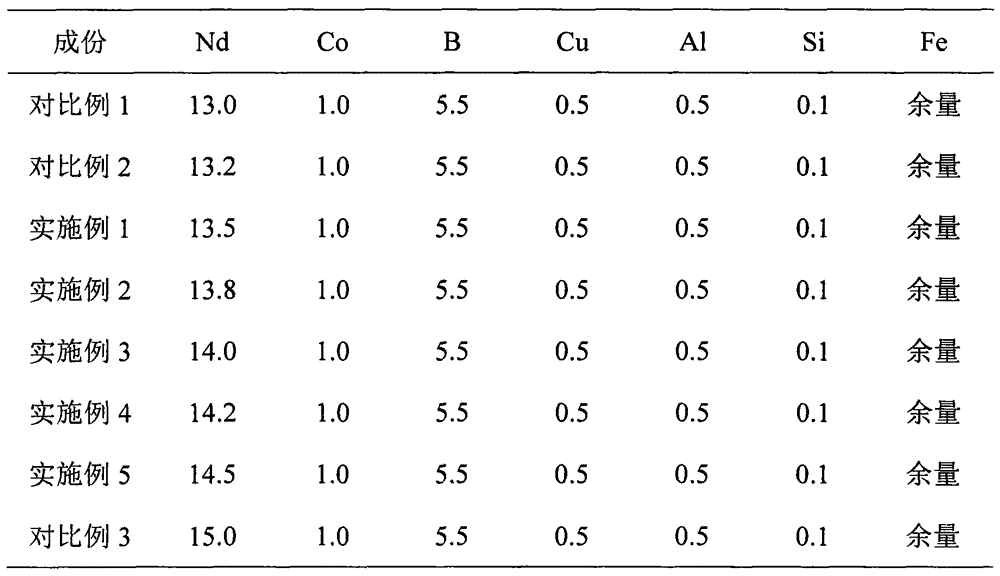Low-B rare earth magnet
A technology of rare earth magnets and rare earth elements, applied in the field of magnet manufacturing, can solve problems such as lack of magnet squareness, failure to improve thermal demagnetization, etc., achieve good heat resistance, improve squareness, and increase coercive force Effect
- Summary
- Abstract
- Description
- Claims
- Application Information
AI Technical Summary
Problems solved by technology
Method used
Image
Examples
Embodiment 1
[0046] In the raw material preparation process: prepare Nd with a purity of 99.5%, Fe-B for industrial use, pure Fe for industrial use, Co with a purity of 99.9%, Cu, Al, and Si with a purity of 99.5%, and prepare them in atomic percent at%.
[0047] The contents of each element are shown in Table 1:
[0048] The ratio of each element in table 1
[0049]
[0050]
[0051] Each serial number group was prepared according to the element composition in Table 1, and 100Kg of raw materials were weighed and prepared respectively.
[0052] Melting process: Take 1 prepared raw material each time and put it into a crucible made of alumina, and heat it in a high-frequency vacuum induction melting furnace at 10 -2 Vacuum melting is carried out at a temperature below 1500°C in a vacuum of Pa.
[0053] Casting process: Ar gas is introduced into the smelting furnace after vacuum smelting to make the pressure reach 50,000 Pa, and then casting is carried out by single-roll quenching me...
Embodiment 2
[0074] In the raw material preparation process: prepare Nd with a purity of 99.9%, B with a purity of 99.9%, Fe with a purity of 99.9%, Co with a purity of 99.9%, and Cu, Al, Ga, and Si with a purity of 99.5%, and prepare them in atomic percentage at%.
[0075] The contents of each element are shown in Table 3:
[0076] The ratio of each element in table 3
[0077]
[0078] Each serial number group was prepared according to the element composition in Table 3, and 100Kg of raw materials were weighed and prepared respectively.
[0079] Melting process: Take 1 prepared raw material each time and put it into a crucible made of alumina, and heat it in a high-frequency vacuum induction melting furnace at 10 -2 Vacuum melting is carried out at a temperature below 1500°C in a vacuum of Pa.
[0080] Casting process: Ar gas is introduced into the smelting furnace after vacuum smelting to make the pressure reach 50,000 Pa, and then casting is carried out by single-roll quenching met...
Embodiment 3
[0097] In the raw material preparation process: prepare Nd with a purity of 99.5%, Fe-B for industrial use, pure Fe for industrial use, Co with a purity of 99.9% and Cu with a purity of 99.5%, and prepare them in atomic percent at%.
[0098] The contents of each element are shown in Table 5:
[0099] The ratio of each element in table 5
[0100]
[0101]
[0102] Each serial number group was prepared according to the element composition in Table 5, and 100Kg of raw materials were weighed and prepared respectively.
[0103] Melting process: Take 1 prepared raw material each time and put it into a crucible made of alumina, and heat it in a high-frequency vacuum induction melting furnace at 10 -2 Vacuum melting is carried out at a temperature below 1500°C in a vacuum of Pa.
[0104] Casting process: Ar gas is introduced into the smelting furnace after vacuum smelting to make the pressure reach 50,000 Pa, and then casting is carried out by single-roll quenching method, wit...
PUM
| Property | Measurement | Unit |
|---|---|---|
| particle diameter | aaaaa | aaaaa |
| purity | aaaaa | aaaaa |
Abstract
Description
Claims
Application Information
 Login to View More
Login to View More - R&D
- Intellectual Property
- Life Sciences
- Materials
- Tech Scout
- Unparalleled Data Quality
- Higher Quality Content
- 60% Fewer Hallucinations
Browse by: Latest US Patents, China's latest patents, Technical Efficacy Thesaurus, Application Domain, Technology Topic, Popular Technical Reports.
© 2025 PatSnap. All rights reserved.Legal|Privacy policy|Modern Slavery Act Transparency Statement|Sitemap|About US| Contact US: help@patsnap.com



